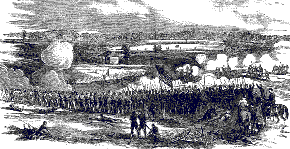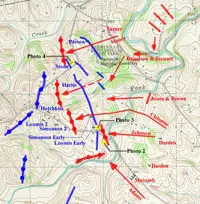 | |||||||||||||||||||||
|
Books on The Battle of Perryville

The Battle of Perryville began with a middle-of-the-night skirmish over a source of precious drinking water, and ended more or less by default with the onset of darkness and the retreat of the tactical victor, the Confederates. It marked the end of the Kentucky Campaign of Gen. Braxton Bragg and Maj. Gen. E. Kirby Smith and, like the campaign, was marked not only by fierce fighting and heroic achievement, but also by indecision, confusion, and futility on both sides.
The initiative to invade Kentucky came primarily from Smith, then commander of the Department of East Tennessee. He believed the campaign would allow them to obtain supplies, enlist recruits, divert Union troops from Tennessee, and claim Kentucky for the Confederacy.
While Gen. Robert E. Lee was attacking Maryland, Bragg and Maj. Gen. Don C. Buell were going at it out in the West. After the replacement of commanders on both sides, (Buell replaced Maj. Gen. Henry W. Halleck and Bragg replaced Gen. P.G.T. Beauregard) each President ordered them to plan an offensive. Buell continued Halleck's march southward until he heard of the advancing Bragg to the east of him. When Bragg arrived in Chattanooga he planned, with Smith, an attack on Buell that would finish him. Then Bragg and Smith would head west to attack Maj. Gen. Ulysses S. Grant.
 Click On Map To Enlarge |
Bragg and Smith met in Chattanooga on July 31 and agreed to invade Kentucky. From Knoxville, Smith marched north with 10,000 men, and by September 3, had occupied the provisional Confederate capital, Frankfort. Bragg's 30,000 troops left Chattanooga, beseiged Munfordville, Kentucky, moved north toward Louisville, then veered east, occupying Bardstown. Two of Bragg's subordinates, Maj. Gens. Leonidas Polk and William J. Hardee, screened the area southeast of Louisville, while Bragg went to Frankfort to supervise the installation of the Confederate state government. Buell's force at Nasville timidly pursued Bragg through September, then entered Louisville on September 25.
On September 7, Buell's Army of the Ohio left Nashville and began racing Bragg to Louisville.
On the way, Bragg was distracted from his objective by the capture of a Union fort at Munfordville. Now, he had to decide again whether to continue toward a fight with Buell (over Louisville) or rejoin Smith, who had gained control of the center of the state by capturing Richmond and Lexington and threatened to move on Cincinnati. He chose to rejoin Smith. This allowed Buell to reach Louisville where he reorganized and reinforced his army with thousands of new recruits. Meanwhile, Bragg met Smith in Frankfort where Bragg believed the main body of the Union army was. There he was able to attend the inauguration of Confederate Governor Richard Hawes on October 4.
On October 1, in the middle of one of the worst droughts in years, Buell left Louisville with more than 50,000 men. Divided into 4 columns, they fanned out east and south. Following seperate routes, Maj. Gen. Alexander M. McCook's I Corps on the left, Maj. Gen. Thomas L. Crittenden's II Corps at the center, and Brig. Gen. Charles C. Gilbert's on the right all headed for Bardstown and Harrodsburg, towns suothwest of Frankfort. Buell's second in command, Maj. Gen. George H. Thomas, traveled with Crittenden. Brig. Gen. Ebeneezer Dumont, at the head of the 4th column, led a large division directly east for a demonstration against Frankfort.
Poor intelligence convinced Bragg that Federals would attack Frankfort or Versailles to its south. Believing Dumont's column to be Buell's vanguard, he concentrated Kirby Smith's force around Frankfort. Unaware of the 3 intervening Union columns, he ordered Polk to attack Dumont's south flank.
Cavalry informed Polk of a growing force to his north. Advising Bragg of his movements, Polk sent Hardee to Perryville, southwest of Harrodsburg and 70 miles southeast of Louisville. His own troops concentrated at Hrrodsburg, where Bragg joined him on the 5th, urging that he and Hardee hurry north to the defense of Frankfort or Versailles. Hardee expressed concern about advance Union elements appearing west of Perryville, feared being attacked in flank if he moved north and on the 6th requested reinforcements. Pursuaded that Hardee faced only a large Union demonstration, Bragg testily agreed that Polk and Brig. Gen. James P. Anderson's division could move south to Perryville. He said the force should "give the enemy battle immediately; route him, and then move to our support of Versailles".
On October 6, the approach of the large Union force caused the Confederates to withdraw eastward to Perryville. The area had been afflicted by a drought for months. The heat was oppressive for both men and horses, and the few useful sources of drinking water provided by the rivers and creeks west of town were desperately sought after.
On October 7, the Buell's army, numbering nearly 55,000, converged on the small crossroads town of Perryville in 3 columns. The 3 main Union columns suffered in unusual autumn heat and desperate for water, advance elements moved on October 6-7 toward Perryville, where shallow pools were reported in the bed of Doctor's Fork, a tributary of the Chaplin River 1.75 miles northwest of the town. Buell ordered all corps to concentrate there, but only Gilbert's men arrived that day, near dusk. His vanguard and advance skirmishers of the other 2 columns had had sharp fights for 2 days with Confederate pickets guarding the little water remaining in Doctor's Fork. All columns had passed through Bardstown or south of Harrodsburg and did not know Polk's position or the number of troops in Perryville. Polk, with Anderson's division, had joined Hardee, and the night of October 7, in council, the commanders decided to let the Union army make the first move.
Union forces first skirmished with Confederate cavalry on the Springfield Pike before the fighting became more general, on Peters Hill, as the Confederate infantry arrived.
On October 8, at dawn, fighting began again around Peters Hill as a Union division advanced up the pike, halting just before the Confederate line. The fighting then stopped for a time. After noon, a Confederate division struck the Union left flank and forced it to fall back.
When more Confederate divisions joined the fray, the Union line made a stubborn stand, counter attacked, but finally fell back with some troops routed. Buell did not know of the happenings on the field, or he would have sent forward some reserves. Even so, the Union troops on the left flank, reinforced by 2 brigades, stabilized their line, and the Confederate attack sputtered to a halt.
Later, a Confederate brigade assaulted the Union division on the Springfield Pike but was repulsed and fell back into Perryville. The Federals pursued, and skirmishing occurred in the streets in the evening before dark. Union reinforcements were threatening the Confederate left flank by now.
The Confederate forces held their ground until Bragg, finally realizing that the main body of the Union army was in the area, gave the order around midnight to retreat. Buell did not know his opponent had abandoned the field until Crittendon's II Corps moved into Perryville at 10:30 the next morning. He did not begin to follow after them until the following day, October 10. Bragg united his forces with Smith's at Harrodsburg, and the Union and Confederate armies, now of comparable size, shadow boxed with one another over the next week or so but neither attacked.
Bragg soon realized that the sources of help he had hoped for (Gen. Robert E. Lee from Virginia, Maj. Gen. Earl Van Dorn and Maj. Gen. Sterling Price from Mississippi, and new recruits from Kentucky) would not materialize, and he made his way southeast to Knoxville, Tennessee. He was quickly called to the Confederate capital, Richmond, Virginia, to explain to Jefferson Davis the charges brought by his officers about how he had conducted his campaign. Buell called off his "pursuit" of Bragg and returned to Nashville.
On October 24, a change of command structure in the Union army relieved him of his duties and more or less ended his career. Perryville's homes and farms were left in shambles by the battle. The main force of the Union army had buried most of their dead in long trenches before pursuing Bragg, but most of the Confederate dead were still unburied for up to a full week after the battle. Union soldiers finally forced local residents to help them bury the dead in shallow trenches.
Immediately after the battle, Lincoln replaced Buell with Brig. Gen. William S. Rosecrans, hoping to, for once, find a good general in the West. Bragg was just as much a failure as Buell, but was not replaced. His men had marched over 500 miles, ended up right back were they started and had fought only one losing battle. The Confederates won a tactical victory by pushing most of the Union forces back from the strategic high ground and sources of water over which they fought, but they immediately abandoned the land they had gained at such a high price when they realized they had been opposed by less than half of the Union troops in the area.
The Confederate "victory" marked the end of their last offensive campaign in the West, and their retreat left the border state of Kentucky under the control of the Union army for the rest of the war. The battle was not really considered a victory for either side, for it had stalled the movement of both armies and both armies were right back where they started.
